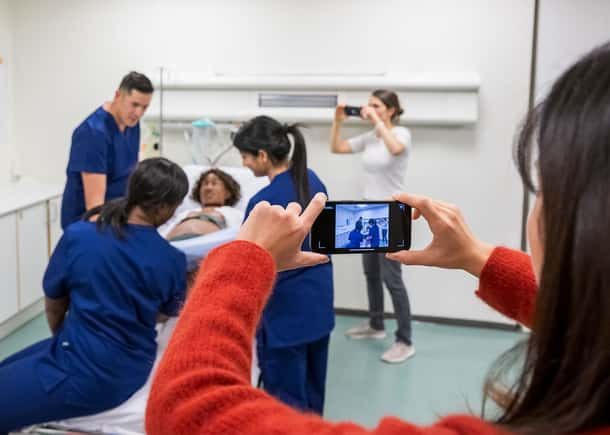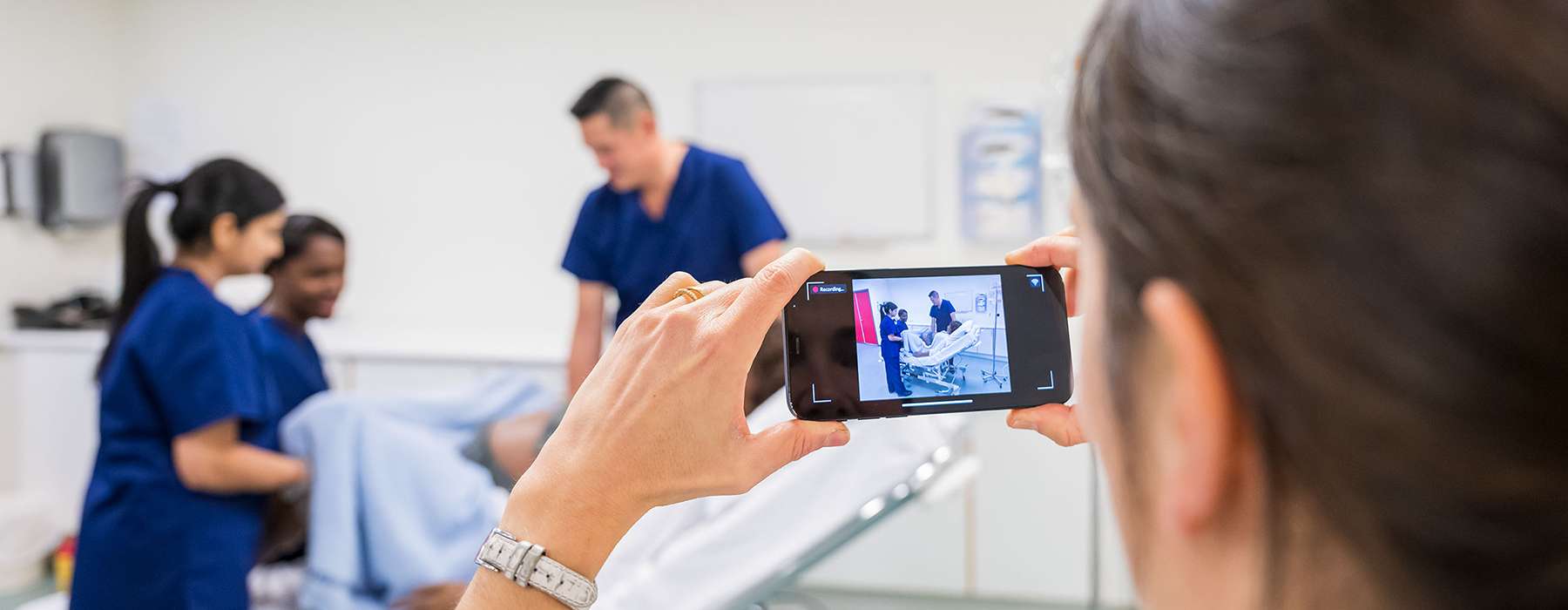Driving Quality Improvement in Obstetrics through Simulation
Tackling Today’s Top Challenges

Tackling Today’s Top Challenges

Obstetric care is one of the most complex, high-stakes areas in healthcare — and one of the most scrutinized. Effective management of emergencies like postpartum hemorrhage and hypertensive disorders requires a strong system of care.
Yet many of the most pressing challenges stem from systems-level gaps: the structures, processes, and resources that support (or hinder) safe, effective care.
For OB/GYN leadership, risk managers, and quality teams, the end goal is not just to reduce preventable harm but also to strengthen the systems and teamwork that enable consistent, patient-centered maternity care — ensuring timely recognition, prevention, and management of complications.
Simulation offers a path forward. In obstetrics, experience is critical—but it takes years to build. Waiting to accumulate experience in low-frequency, high-acuity events is not a reliable way to prepare.
- Andrew Petrosoniak, MD, MSc (Med Ed), FRCPC
Emergency Physician and Trauma Team Leader at St. Michael’s Hospital in Toronto, Canada
Using simulation to recreate critical obstetric events in a safe, controlled environment can expose weaknesses in workflows, protocols, and resources. This allows you to address system-level vulnerabilities before they impact real patients.
In this article, we explore some of today’s top challenges in obstetrics and how simulation can help create a safer system.

You know the statistics. You live them every day.
The system challenge: Delays in escalating care, confusion about roles, sub-optimal teamwork, protocol issues, or resource constraints often stand in the way of timely response to postpartum hemorrhage. These are failures of system design, not necessarily individual skill.
How simulation helps: Simulation has been shown to improve performance during postpartum hemorrhage.4 Using a high-fidelity maternal and birthing simulator allows your teams to progress together through a lifelike postpartum hemorrhage scenario.
Examine your massive transfusion workflows, communication handoffs, and escalation processes. You’ll gain visibility into where bottlenecks exist and what system changes are needed to ensure a seamless, coordinated response.
Pullman Regional Hospital simulated a postpartum hemorrhage. Through simulation, they were able to capture key performance data, including the time taken to order and receive blood from the lab. Actions were measured against time and the amount of blood lost.
The performance data uncovered that there was room for improvement in the amount of time it was taking to get blood from the blood bank. This is an issue that exists in many hospitals.
Having objective data specific to their hospital gave them pathways to focus on in their Quality Assurance and Performance Improvement (QAPI) program. Using the data, they were able to set goals, make improvements, and then simulate again to help them measure their progress a few months later.
The results were remarkable:
- Amber Roberts, MSN, RN
Hospital Education Coordinator, Pullman Regional Hospital


The system challenge: Breakdowns often happen not from lack of knowledge, but from unclear escalation protocols, missed diagnostic cues, and poor communications.
How simulation helps: A high-fidelity maternal and birthing simulator provides the ability to recreate preeclampsia and hypertensive disorder scenarios – allowing you to address systems challenges. In this risk-free environment, you can test factors like monitoring systems, escalation protocols, and specialist availability. As issues are uncovered and addressed, simulation can be later used again to test the effectiveness of your mitigation strategies.
To deepen the impact of your scenarios, pairing them with a simulation management and recording system can be transformative. By automatically capturing video of your sessions, these platforms allow you to review workflows, communication handoffs, and escalation processes in detail.
Built-in AI capabilities further streamline the process by generating checklists and searchable transcripts to aid debriefing. This added layer of efficiency makes it faster and easier to pinpoint bottlenecks, guide focused discussions, and identify the system changes needed for a seamless, coordinated response.

If you are like many in Obstetrics, medication errors are a point of major concern.
The system challenge: In high-stress obstetric emergencies, medication errors – from incorrect dosing to mislabeling – are a significant risk. These errors frequently stem from workflow design, labeling practices, or pump programming – not simply individual oversight.
“The ‘five rights’ of medication administration focuses on individual factors and not necessarily on system flaws,” explains Jennifer Vuu Sanchez, RN, Patient Safety Program Director at CRICO. “So it is possible that even if a nurse completes the five rights of medication administration, there could be systems issues in place that may interfere with safe medication practices.”7
How simulation helps: Medication-focused simulations recreate administration processes from end to end, exposing where the system is vulnerable. You can then refine labeling standards, storage protocols, and communication workflows to prevent errors before they reach patients.

The system challenge: Misdiagnosis and delay in diagnosis are significant contributors to preventable harm in obstetrics.8 But too often, diagnosis is treated as an individual’s judgment, when evidence shows that errors usually stem from system failures, not personal shortcomings.9
Common systems failures are delays in information flow, lack of decision-support tools, and unclear escalation processes.
How simulation helps: Diagnostic simulations highlight whether teams are supported with the right data, pathways, and resources to act decisively. Simulation allows teams to practice the diagnostic process and get real-time feedback.
Simulations yield data that can help pinpoint which obstetric cases have the most frequent diagnostic errors, allowing you to prioritize them for quality improvement. A simulation management system can help you organize the data and gain actionable insights.

Laerdal's mission is Helping Save Lives. We believe that no one should die or be disabled unnecessarily during birth, from sudden illness, trauma, or medical errors.
We are committed to providing tools that empower healthcare systems to deliver the best possible care for mother and baby.
1. Petrosoniak, A. (2025, February 19). What’s the value of training for HALO (high acuty, low occurrence) events? Linkedin.com. https://www.linkedin.com/posts/andrew-petrosoniak_simulation-activity-7298048153130254339-EJnz/
2. World Health Organization. (2023, March 10). WHO Postpartum Haemorrhage Summit. Www.who.int. https://www.who.int/news-room/events/detail/2023/03/07/default-calendar/who-postpartum-haemorrhage-summit
3. Ibid.
4. Lipman, S. S., Carvalho, B., Cohen, S. E., Druzin, M. L., & Daniels, K. (2012). Response times for emergency cesarean delivery: use of simulation drills to assess and improve obstetric team performance. Journal of Perinatology, 33(4), 259–263. https://doi.org/10.1038/jp.2012.98
5. May Is Preeclampsia Awareness Month. (2025). Preeclampsia Foundation. https://www.preeclampsia.org/AwarenessMonth
6. Cooke, E., Sabol, B. A., & Rampersad, R. (2019). 212: Medication events leading to patient harm in an inpatient obstetrics unit. American Journal of Obstetrics and Gynecology, 222(1), S147–S147. https://doi.org/10.1016/j.ajog.2019.11.228
7. Augello, T. (2024, May 14). Med Error Leads to Change in L&D Policy. Harvard.edu; CRICO. https://www.rmf.harvard.edu/Podcasts/2024/OD-in-Labor-and-Delivery-Pushes-Change
8. Krenitsky, N. M., Perez-Urbano, I., & Goffman, D. (2024). Diagnostic Errors in Obstetric Morbidity and Mortality: Methods for and Challenges in Seeking Diagnostic Excellence. Journal of Clinical Medicine, 13(14), 4245–4245. https://doi.org/10.3390/jcm13144245
9. Diagnosis errors are a system problem, not just doctor’s fault |…. (2015). Clinician.com. https://www.clinician.com/articles/136459-diagnosis-errors-are-a-system-problem-not-just-doctors-fault